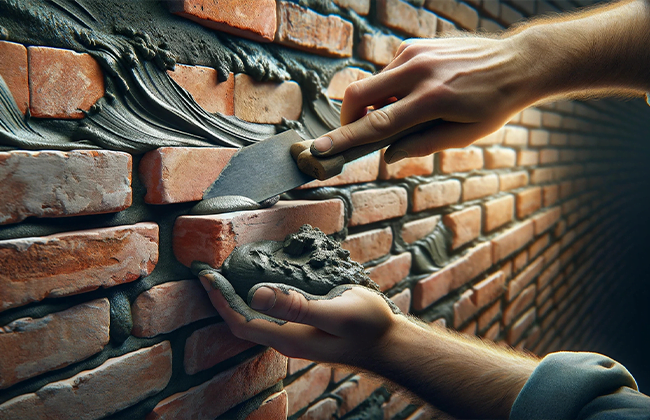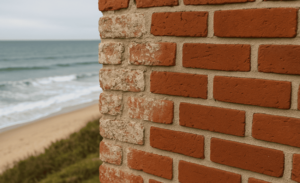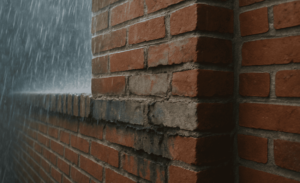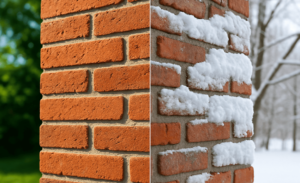Brick pointing is a critical aspect of maintaining the structural integrity and aesthetic appeal of brick constructions. Understanding brick pointing cost is essential for homeowners looking to preserve their property’s value and prevent future damage. This guide provides a detailed overview of the factors that influence the costs associated with brick pointing, helping you make informed decisions about your home maintenance.
What is Brick Pointing?
Brick pointing, or simply “pointing,” is the process of renewing the mortar joints between bricks. Over time, these mortar joints can weather or decay due to exposure to various elements like rain, frost, and heat. This can lead to water seeping into the brickwork, potentially causing structural damage or damp issues inside the building. By carefully removing the old mortar and replacing it with new, fresh mortar, pointing ensures the longevity of the brickwork, improves its appearance, and protects the building against moisture and other external factors.
Factors Influencing Brick Pointing Cost
When planning for brick pointing, it’s essential to consider various factors that can affect the total cost of the project. Here’s a more detailed look:
- Extent of Damage: The cost of brick pointing largely depends on how much of your brickwork needs repair. Small, localized repairs are usually more affordable. However, if large portions of your wall are damaged, you’re looking at a more significant investment. More extensive damage requires more materials and labor, driving up the cost.
- Type of Mortar Used: The type of mortar you choose plays a crucial role in both the cost and the effectiveness of the repair. Traditional lime mortar is often used in older or historical buildings because it offers better flexibility and breathability, which can be crucial for the structural integrity of such buildings. However, lime mortar can be more expensive and harder to work with than modern cement-based mortars, which are cheaper but less flexible. Choosing the right mortar will depend on your building’s needs and the specific environmental conditions it faces.
- Accessibility: The ease with which workers can access the areas that need repair also affects the cost. Jobs on higher floors or in tight spaces might require scaffolding or specialized equipment, which can increase the overall price. Additionally, if the property is located in a busy or restricted area, permits may be needed, adding to the cost.
- Location: Labor costs vary significantly across different parts of the country. Urban areas tend to have higher rates than rural areas. Furthermore, local availability of materials can also affect prices; regions where materials are readily available might see lower costs compared to areas where materials need to be shipped in.
- Size of the Property: Larger buildings with more brickwork naturally incur higher costs for pointing due to the volume of mortar needed and the time it takes to complete the job.
- Contractor Selection: The expertise and reputation of the contractor you choose will also impact your budget. Highly skilled professionals may charge more, but the quality of work can prevent future expenses related to quick fixes or poor craftsmanship.
Detailed Breakdown of Brick Pointing Cost
Understanding the cost dynamics of brick pointing can help you budget effectively for your maintenance or restoration project. Costs can vary based on the size of the area you need to point and the complexity of the job. Here’s a detailed look:
Table 1: Cost by Project Size
| Project Size | Average Cost |
| Small patch | $500 – $800 |
| Medium section | $800 – $1,500 |
| Large area | $1,500 – $3,000 |
Explanation of Costs by Project Size:
- Small patch: This typically involves minor repairs such as filling in a few cracks or re-pointing a small section of a wall. It’s relatively quick and uses less material, keeping costs lower.
- Medium section: This might include a significant portion of a wall or several patches throughout a property. It requires more time and materials, hence the higher cost.
- Large area: This could entail re-pointing an entire building or a large wall. Such projects often require multiple days of labor and significantly more materials, driving up the cost.
Table 2: Cost by Complexity
| Complexity | Average Cost |
| Low | $500 – $1,000 |
| Medium | $1,000 – $2,000 |
| High | $2,000 – $4,000 |
Explanation of Costs by Complexity:
- Low complexity: Simple projects that involve straightforward re-pointing without the need for extensive surface preparation or special treatments.
- Medium complexity: These projects may involve accessing harder-to-reach areas, requiring special equipment or techniques, or dealing with moderately deteriorated mortar that requires more careful removal and preparation.
- High complexity: These jobs often deal with historic or very delicate brickwork requiring specialized mortars and techniques. High complexity projects may also involve extensive surface preparation and the use of scaffolding or other equipment to ensure safety and precision.
How to Choose a Brick Pointing Contractor?
Choosing a competent contractor is vital to ensure that your brick pointing job is done effectively and lasts for years. Here are some detailed steps to guide you in selecting the right contractor for your brick pointing needs:
Experience:
Look for contractors who have extensive experience specifically in brick pointing. Experience in this field is crucial because it indicates that the contractor understands the nuances of different types of mortar and brickwork. Check how long they have been in the business and ask for examples of previous projects similar to yours.
Reviews and Testimonials:
Nowadays, it’s easy to learn about the quality of a contractor’s work through online reviews and testimonials. Websites like Yelp, Google Reviews, and even Facebook can provide insights from previous customers about their satisfaction with the contractor’s work. Pay attention to comments about the contractor’s professionalism, timeliness, and response to issues.
Licenses and Insurance:
Ensure that any contractor you consider is licensed and insured. This protects you legally and financially if something goes wrong during the project. A licensed contractor has met the industry standards required by local authorities, and insurance coverage means you won’t be liable for accidents or damages during the project.
Quotations:
It’s wise to get detailed quotes from at least three contractors. This will not only give you a sense of the market rate for your project but also offer an insight into the thoroughness of each contractor. A detailed quote should outline the scope of work, the materials to be used, the timeframe for completion, and the total cost. Comparing these quotes can help you understand which contractor offers the best value.
References:
Ask for references from each contractor and take the time to follow up on them. Speaking to past clients can provide a first-hand account of what you can expect. Ask these references about the contractor’s ability to stay on budget, the quality of the craftsmanship, and their overall satisfaction with the project.
Personal Interaction:
Finally, consider how the contractor communicates with you. Are they punctual for appointments? Do they answer your questions clearly and thoroughly? The contractor’s ability to communicate effectively is often a good indicator of how smoothly the project will go.
DIY Brick Pointing: Is it Feasible?
Deciding to handle brick pointing on your own can be a cost-effective solution if you’re handy and equipped with the right tools and knowledge. However, it’s essential to carefully assess whether you have the necessary skills and resources to ensure the job is done right. Here’s what you need to consider:
Understanding of Materials:
Knowledge of the different types of mortar and their compatibility with your existing brickwork is crucial. You’ll need to match the new mortar to the old in terms of composition, color, and texture to ensure durability and aesthetic coherence.
Tools Required:
You will need specific tools for a proper pointing job. These include a chisel and hammer for removing old mortar, a pointing trowel to apply new mortar, a mixing hoe or paddle for preparing mortar, and possibly a scaffold or ladder for higher areas. Safety equipment like gloves, goggles, and a dust mask are also essential to protect yourself during the work.
Skills Needed:
Effective brick pointing requires precision. You’ll need to be adept at removing old mortar without damaging the bricks, mixing mortar to the right consistency, and applying it smoothly and securely into the joints. If you’re new to masonry work, consider practicing on a less visible area or taking a workshop or class before starting.
Time Commitment:
Brick pointing can be time-consuming, especially for beginners. You need to allow enough time to remove the old mortar, prepare the surface, mix the mortar, apply it, and then clean up. Rushing through any of these steps can compromise the quality of the job.
Potential Risks:
Incorrectly done brick pointing can lead to water infiltration, further brick damage, and even structural issues over time. If you’re not confident in your ability to perform the work at a professional level, it might be safer and more cost-effective in the long run to hire a professional.
Cost-Benefit Analysis:
While doing it yourself can save on labor costs, consider the expense of tools and materials, along with the potential cost of fixing mistakes. Sometimes, hiring a professional can be more economical when factoring in these elements.
Long-term Savings from Brick Pointing Cost
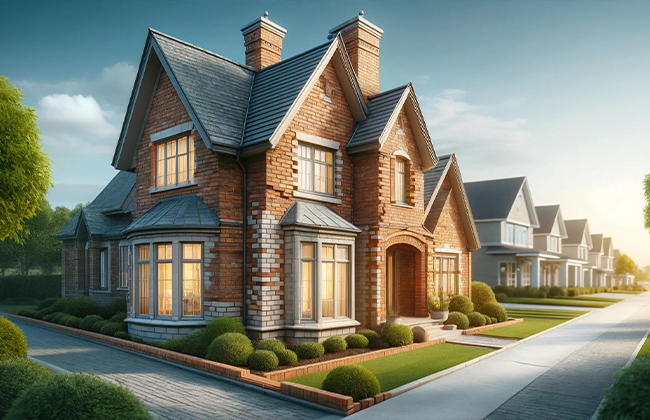
Opting for professional brick pointing offers several long-term advantages that go beyond the immediate restoration of your property’s appearance. Here’s why professional pointing is an investment worth considering:
Extended Lifespan of Brickwork:
Professional brick pointers use high-quality materials and techniques that ensure the mortar lasts as long as possible. By effectively sealing joints against water ingress and environmental damage, professional work extends the lifespan of your entire brick structure.
Prevention of Water Damage:
Properly executed pointing prevents water from penetrating the brickwork, which is crucial to avoiding damp issues inside the building. Water penetration can lead to costly repairs in wall interiors and other structural components. Professionals ensure that all joints are thoroughly filled and sealed.
Enhanced Property Value:
Good pointing enhances curb appeal, which can significantly increase your property’s market value. A well-maintained exterior is a key selling point, and prospective buyers or tenants often view new pointing as a sign that the property has been well cared for.
Energy Efficiency:
By securing the mortar joints, professional pointing can also improve thermal insulation. This reduces air infiltration, which can help in maintaining indoor temperature and lowering energy costs associated with heating or cooling your home.
Cost-Effective Maintenance:
While the initial cost of professional pointing might be higher than DIY attempts, the quality and durability of the work often mean fewer repairs and less maintenance over time. This can save a considerable amount of money, reducing the overall lifecycle cost of your brickwork.
Structural Integrity:
A professional brick pointer will not only repair existing damage but also identify and address potential weak points in your brickwork. This proactive approach can prevent minor issues from developing into major structural problems, thus avoiding disruptive and expensive repairs later.
Conclusion:
In conclusion, accurately estimating brick pointing costs ensures that your property remains in top condition, safeguarding against structural issues and enhancing its aesthetic value. If you’re searching for a professional contractor for brick pointing, understanding these costs can guide your decision-making. For expert services, feel free to contact us at (+1) 917-355-8556 to discuss your needs and get a detailed quote.
FAQs:
Q: What are the average brick pointing cost factors?
A: The brick pointing cost can vary based on several factors such as the extent of damage, the type of mortar required, the accessibility of the area being pointed, and the geographical location. Understanding these factors will help you budget more accurately for the project.
Q: How can I get the best value for my brick pointing cost?
A: To ensure you get the best value for your brick pointing cost, it’s advisable to seek quotes from several contractors to compare prices. Additionally, checking the contractor’s past work and reviews will help you gauge the quality you can expect for the price quoted.
Q: What should I include in my budget for brick pointing cost?
A: When budgeting for brick pointing cost, include not only the direct labor and material costs but also potential scaffolding costs, any special equipment needed for hard-to-reach areas, and possibly a contingency for unforeseen complications.
Q: Can brick pointing cost vary seasonally?
A: Yes, brick pointing cost can sometimes vary seasonally. Spring and summer are typically busier seasons for masonry work, which might affect availability and rates. Planning your project for the off-season could potentially reduce costs.
Q: What long-term savings does managing brick pointing cost offer?
A: Managing your brick pointing cost effectively by investing in quality workmanship can lead to significant long-term savings. Proper brick pointing prevents structural damages, reduces repair frequency, and maintains your property’s value, all of which contribute to overall cost savings over time.

